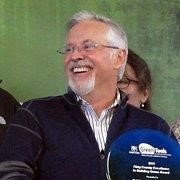Landscape Architect in the Wild: Michael Popiwny
After reading Ian McHarg’s “Design with Nature,” Popiwny began his path in landscape architecture at the University of Pennsylvania. There he studied under McHarg for three years, in a program with highly-devoted students, learning landscape architecture and large-scale master planning. He says of his experience at UPenn that not only was having a rich education important, and that students should attend the school they believe is the very best, but also being immersed in a program with like-minded and dedicated students that pushed each other was motivating and influential. Post-graduation, he worked at Wallace Roberts & Todd before moving to Washington. After relocating west, Popiwny was hired by a private firm and then the Port of Seattle working on large-scale projects, two of the largest being the West Point Treatment Facility and the Bell street Pier as the Development Manager. He was essentially a design project manager for West Point, and that is what led him to apply for the job as project manager for Brightwater. The application process was rigorous, and the lengthy interview procedure included sitting down with his competing applicants and having a conversation, which was then analyzed for effective working behaviors by an independent review firm. After undergoing that process and ultimately being hired by King County, it was no surprise that he was able to handle the many challenges presented to him with managing the giant $1.9 billion Brightwater siting and design project. Popiwny says he uses his training as a landscape architect “everyday.” His skills in landscape architecture help him with “analysis and understanding of a problem and working towards a solution.” He adds that he gained experience working for a firm that allowed him to do multi-disciplinary work and practice negotiating. He also has more sympathy for designers and fostered creative skills that help him to “do more with an allotted budget”. For emerging project managers, he says “do the best project you can do.” He is always trying to inspire and motivate his team for success by maintaining an on-going positive attitude, and encourages those of every position to do the same. He purposefully cultivates and grows a talented staff, and listens to those around him, asking the positives and negatives so that they can rationally look at problems to figure out the best solution. He consults with experts who have a deep technical knowledge, and acts as a balance between those experts. He advises those looking to progress to look at their strengths and weaknesses and know their limitations. What are you best at? Pursue that. He encourages his interns to interact with the community directly on their projects. That way they can develop those crucial communication, negotiation and management skills that are not taught in school, but come with experience. Those, he says, will be crucial in helping them advance in the future. After a certain point management of staff and a “sales mentality” to get projects built, in addition to technical training in landscape architecture, become your day-to-day work. He also says that, “if you can do a small project well, you can do a big project well,” and that “projects are scalable;” skills developed on small projects are directly applicable to large projects. He also points out that if you’re working under someone, it is ok to speak up about something that you find wrong or incorrect, and it may be helpful to “walk away to talk to your lead afterwards,” in private. It is important to be confident about your abilities and to be assertive. When asked how he measures success on a day-to-day basis, and how he knows if he is doing his job well and serving the public well, he states, “any project is just these small increments, and you’re always working to get that one step done so that it leads to the next… for me it’s those small successes along the way.” He mentions that success is that feeling that everything is ok, whether it’s putting a schedule together that feels like it works or having a community feel less suspicious of your ability to deliver your project. He states that you have to be motivational and inspirational for your team. He elaborates, “Sometimes you have to be the one believing in some aspect of a project that you think is really important, and continue to fight for it. And sometimes, with these big projects, you’re fighting for that for years, trying to figure out ways to gain support for it, to continue to show progress, to sell it, to add value, and sometimes you have to do that over and over again…. motivation, attitude, persistence can really make somebody successful.” -Stephanie Stroud
|

